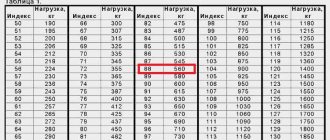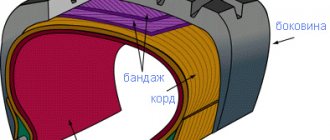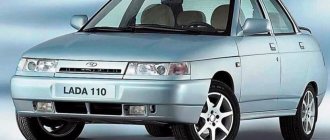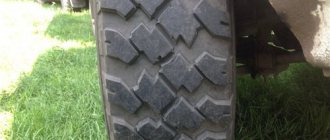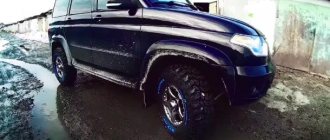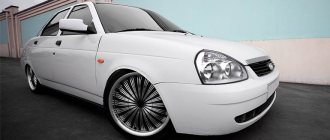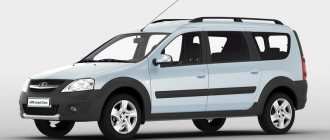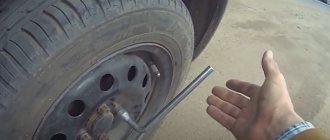The rezulteo tire buyer's guide will help you choose winter and summer tires for your LADA Largus Cross. The technical characteristics of your LADA Largus Cross 1.6 L 105 allow us to provide you with the sizes of suitable tires (width, height, diameter in inches, speed and load indices), as well as other useful information about your car, including the recommended tire pressure for LADA Largus Cross 1.6 L 105. Below are the tire sizes for the LADA Largus Cross 1.6 L 105. In order to select tires available in this size, as well as get acquainted with prices, test results and find out where you can buy them, click on the “Show” button tires."
Tires directly affect fuel consumption, vehicle cross-country ability, its behavior on the road, and noise level. The appearance of the vehicle also depends on the tires.
AvtoVAZ recommends a certain wheel size for Lada Largus. Let's consider the parameters allowed by the manufacturer and study possible variations. Let's get acquainted with the top 5 winter and summer tires (according to owner reviews).
ATTENTION! A completely simple way to reduce fuel consumption has been found! Don't believe me? An auto mechanic with 15 years of experience also didn’t believe it until he tried it. And now he saves 35,000 rubles a year on gasoline! Read more"
Lada Largus is represented by three models (Largus R90, F90, Cross). Options with 7 or 5 seats are produced (except for the F90 cargo vehicle). The basic requirements for tires and wheels differ only for the Lada Largus CROSS. Parameters important when choosing wheels are indicated in the user manual. The recommended index of load capacity and speed, the standard air pressure are also set in the instructions.
| Model | Size, load capacity index | Center diameter wheel holes (DIA) | Radius between holes (PCD) | Number of nuts, pcs. | Wheel width, inches | Disc offset (ET) |
| R90 | 185/65R 15 88 H | 60,1 | 100 | 4 | 6J | 50 |
| F90 | 185/65R 15 92 H | 60,1 | 100 | 4 | 6J | 50 |
| CROSS | 205/55R 16 91 H | 60,1 | 100 | 4 | 6J | 50 |
Owners consider the categories of acceptable sizes. One of the reasons is the range of prices; manufacturers have better options among non-standard tires. Sometimes rubber remains from an old car. Some people think that the larger the wheel, the better. Let's learn how to choose safe wheels.
What non-standard sizes can be supplied?
Buy tires based on the full diameter of the wheel. It shouldn't be too different from the standard one.
Standard sizes allowed for installation.
| Model | Size, load capacity index | Center diameter wheel holes (DIA) | Radius between holes (PCD) | Number of nuts, pcs. | Wheel width, inches | Disc offset (ET) |
| R90 | 185/65R 15 88 H | 60,1 | 100 | 4 | 6J | 50 |
| F90 | 185/65R 15 92 H | 60,1 | 100 | 4 | 6J | 50 |
| CROSS | 205/55R 16 91 H | 60,1 | 100 | 4 | 5 ½, 6, 6 ½ J | 50 |
Attention. Replacing recommended sizes with acceptable ones will affect a number of characteristics. The dependence is shown in the table.
| Parameter | Increasing tire width | Increasing rim width |
| Keeping the car on the road | will improve | will improve |
| Accuracy of maintaining a given direction of movement | will improve | will improve |
| Road grip coefficient | will increase on dry roads | does not affect |
| Resistance to aquaplaning effect | will get worse | without changes |
| Traffic noise | will intensify | does not affect |
| Feelings when driving on rough roads | more comfortable | does not affect |
| Fuel consumption | will increase | will increase |
| Tire wear time | will speed up | without changes |
Be sure to calculate the load capacity index. Depending on the model, 88 (560 kg), 92 (630 kg) and 91 (615 kg) are allowed. The speed index is indicated next to the load capacity. T – up to 190 km/h, H – up to 210, V – up to 240.
Generation 2
In 2013, the second generation of Lada Kalina appeared. The car premiered at the Moscow Motor Show a year earlier. After 9 years of producing the debut generation, AvtoVAZ decided to refresh the model, making it more modern. As a result, Lada Kalina II received a new design, a revised range of engines and transmissions, a redesigned interior and a suspension with improved settings.
The eyeliner did the model good. The car has become more dynamic and increased in size. The second Lada Kalina is no longer a miniature city car, but a full-fledged class B hatchback. In this series, AvtoVAZ refused to produce modifications in the sedan body, offering consumers exclusively station wagons and hatchbacks. Other changes include revised front optics and an enlarged mesh grille. The openings for the foglights were also significantly enlarged.
The transformations also affected the interior. The interior of the new Lada Kalina has received higher quality finishing materials. Minor changes affected the center console. In the basic configuration, the list of equipment has become richer.
At the minimum, the car acquired front electric windows, 1 airbag and ABS. This version received a 1.6-liter 8-valve unit (87 hp). More top-end variations were equipped with a 1.6-liter 8-valve engine (98 hp) and a 1.6-liter 16-valve engine (106 hp). A “sport” version with a 118-horsepower unit was also offered. The power plants came in combination with an “automatic” or “mechanical”.
What is the tire pressure
The tire pressure level is specified in the manufacturer's instructions.
| Model | Front tire pressure, kgf/cm² | Rear tire pressure, kgf/cm² |
| R90 | 2,4 | 2,6 |
| F90 | 2,4 | 3,0 |
| CROSS | 2,4 | 2,6 |
Constant monitoring of this parameter is necessary. Fluctuations to a lesser or greater extent affect the behavior of the car, efficiency, and driving safety. Let's look at the relationship more specifically.
Pressure higher than specified:
- the tire is harder, the comfort of movement decreases;
- the risk of damaging the wheel when hitting a stone or hole increases;
- grip on the road deteriorates;
- braking distance increases;
- the tread pattern wears unevenly;
- wheels rotate easier;
- machine stability improves.
Pressure below normal:
- fuel consumption increases;
- rubber wear increases (due to an increase in the contact patch area);
- car steering accuracy deteriorates;
- stability on the road surface decreases (due to changes in the angle of inclination);
- the risk of skidding increases.
When a decrease or excess of pressure is allowed
There are situations in which violating the manufacturer’s recommendations is only for the benefit of the car. We are now talking about the contact patch, which increases with decreasing pressure in the tread and vice versa (decreases with increasing). When might this come in handy?
When driving on soft ground
By reducing the pressure by about one-fourth, you will thereby increase the contact patch by almost one and a half times. Accordingly, the movement will be easier, since the pressure on the soil will decrease.
Thanks for subscribing!
When driving on wet asphalt
By increasing the pressure, you will reduce the contact patch, which will reduce the risk of so-called aquaplaning. However, it should be noted that this rule does not apply to more modern tires, since they are initially designed to drain water.
When moving on rocky ground
In this case, the pressure can be increased, which will reduce the likelihood of damage to the tire sidewall. Don’t forget to return your blood pressure to normal after you’ve completed a difficult section of the trail.
To improve handling
By increasing the pressure, you can improve the car's handling and also reduce fuel consumption. However, you should not get too carried away with this, otherwise, in addition to all the advantages, you can get one rather significant disadvantage - an increased risk of a tire explosion.
Remember that blood pressure tends to decrease gradually, day after day. In summer it decreases a little more, and in cold weather, on the contrary, more slowly. Another important nuance is that some car models have different pressure levels on different axles. Do not forget to control the pressure and pump up the tires if necessary, and then driving will be safe for both you and others.
Lada Kalina is a front-wheel drive car representing the small class. The model replaced AvtoVAZ's budget products with rear-wheel drive. Its production has been carried out in Tolyatti since 2004.
Frequency of checking tire pressure
The tightness of the wheel structure is not ideal. The air gradually comes out. The reduction in pressure directly depends on the air temperature.
Monitoring must be regular. It is optimal to check your blood pressure at least twice a week. Ideal when leaving a parking lot, visiting a gas station, or performing maintenance.
The measurement should be carried out before the tires heat up (for example in the morning) in all wheels, even in the spare wheel. Checking along the way will not give accurate indicators.
The pressure in the tire should be lower than in the other wheels.
Visual assessment of the condition of tires is an irresponsible attitude towards the vehicle and safety. There is a high risk of not noticing a slight decrease or increase in pressure (0.1-0.5 atmospheres).
It must be remembered that temperature fluctuations and vehicle loading lead to changes in the indicator.
In the following situations, it is recommended to reduce the atmosphere to a level lower than the factory instructions:
- when driving on a slippery road (in winter);
- for off-road driving.
What determines tire inflation?
Indeed, the pressure indicator is not a constant value; its change is influenced by several factors, three of which are the most important. The time of year and temperature changes must always be taken into account, so the driver must adjust the amount of air in the tires to suit the weather conditions.
The pressure in R16 tires in winter should always be higher than in summer. When heated, the air mass expands, and if the wheel is overinflated, it can explode. This rule also applies when choosing a driving speed, because the tire rubs against the asphalt and the temperature inside it becomes higher. So those who like to drive fast, and even in the hot season, need to remember their school physics lessons and monitor the tire pressure.
In winter, it is not recommended to senselessly reduce the pressure, as this can lead to disastrous results, but you also should not overinflate the tires. Winter tires are softer than summer tires, so the contact area between the tire and the road is larger. This allows you to drive your car more efficiently on slippery roads. When using all-season tires, sometimes you need to lower the ratings a little.
Tire pressure characteristics
The front and rear wheelsets are inflated differently, no matter whether it’s winter or summer outside. This rule is unshakable. Each car has a specific wheel size.
This information can be found in the vehicle's passport or on the nameplate located on the driver's door frame. The recommended pressure for such tires is also indicated there.
Each car has wheels of a certain size. This information can be found in the vehicle's passport or on the nameplate located on the driver's door frame. The recommended pressure for such tires is also indicated there.
Operating conditions are very important. If there is a snowstorm or thaw outside, then the pressure in the R16 winter tires should be reduced slightly. This is also recommended when driving on sand or on uneven rural roads.
This is also recommended when driving on sand or on uneven rural roads.
If there is a snowstorm or thaw outside, then the pressure in the R16 winter tires should be reduced slightly. It is recommended to do this also when driving on sand or on uneven rural roads.
What tire pressure should be in winter r19
We must not forget about the weight of the car when buying a new set of wheels, as well as its load capacity. Before you hit the road, you need to clarify what the tire pressure should be at the moment, under the given circumstances.
Review of the best summer and winter tires
When choosing tires, owners take into account the following points:
- manufacturer;
- operating conditions (pay attention to the pattern, tread);
- size;
- price category.
Based on reviews from Lada Largus owners, let's summarize.
The majority of survey participants adhere to the recommended sizes. The most popular non-standard tires are 195/65 R15, 195/60 R15, 205/60 R15.
Top 5 summer tires:
- Nokian (HAKKA GREEN 2, Nordman SX);
- Michelin (Energy XM2);
- Continental (ContiPremiumContact 5);
- Matador (MP 44 Elite 3)
- Amtel (Planet T-301). Attention. Complaints about rapid wear. They can burst at high speed.
The tread pattern is:
- asymmetrical;
- directed;
- symmetrical (universal, therefore the most popular).
The latter is ideal for use around the city. It has an affordable price. The downside is unsatisfactory handling at high speed, on wet road surfaces, and when making sharp turns.
Top 5 winter tires:
- Nokian;
- Michelin;
- Continental;
- Goodyear;
- Gislaved/Hankook/Bridgestone.
It is recommended to install standard winter tires. Studded or non-studded - depends on personal preferences and operating conditions. The first option is more popular among Lada Largus owners.
Permissible maximum tire and wheel sizes for Lada Largus
Here everything is limited only by the imagination of the car owner. However, the maximum wheel sizes at which the vehicle will be safe to operate are determined by the manufacturer, who also supplies such wheels from the factory.
That is, the largest wheel size that can be installed on Largus is 205/55 R16. If we move further, the car will require changes in design.
The fact is that the larger the disk or tire, the higher the likelihood that it will touch the fender liner or arch of the Lada Largus. Therefore, car owners resort to tricks for the sake of large rims - they reduce the tire profile.
As a result, the list of sizes is replenished with the following:
- 205/50 R17;
- 205/45 R17;
- 225/45 R17;
- 215/50 R17;
- 215/35 R18;
- 215/40 R18.
For off-road enthusiasts, it is recommended to increase not the diameter of the disk, but the rubber profile. To do this, it is more advisable to install wheels with the following parameters:
- 205/55 R16;
- 195/60 R16;
- 195/55 R16.
The larger profile allows you to move more comfortably over uneven surfaces and protects the disc from dents or cracks.
Tire pressure "Lada Granta"
Cars from the domestic manufacturer Lada Granta are popular even today. This is because their price is low, and even an average family with an average income can afford such a car. The price-quality ratio is approximately the same, although some Lada models still receive a lot of negative reviews on the forums. Owners of such cars often do not think about what pressure standards must be observed. They don’t even know where such parameters are indicated. Similar information can be found in the instruction manual. There the manufacturer describes which indicators are suitable for which modification. Information about the tire sizes suitable for such cars and the number of atmospheres for each option are also provided.
Tire pressure gauge
In 13-inch tires, the permissible level at partial load is 1.9 atmospheres. And when fully loaded, they increase to 2.1 bar on the rear tires. But 14-inch wheels need to be inflated to 2.0 bar. At maximum load of the car, the indicators should be 2.2 Bar on the rear axle tires. The total carrying capacity of the vehicle is 475 kilograms.
Very often, employees of such organizations do not bother and pump all tires to 2.0 bar. And such indicators can be overestimated or underestimated for a particular brand of car. Therefore, the pumping should be controlled independently. A lot of problems can arise due to incorrect pressure. For example, under-inflated tires can lead to:
- quick erasing of side protectors on rubber;
- overheating of tires and their premature deterioration;
- impaired vehicle control, especially when turning;
- excessive fuel consumption.
There are some advantages to underinflated tires:
- soft running of the car;
- no noise or rattling inside the machine.
Overinflated wheels also do not have a very good effect on the condition of the components and parts of the car:
- the suspension wears out quickly;
- the middle tread on the rubber wears off;
- the car drives hard;
- You can hear a rattling sound in the cabin and feel all the bumps and potholes on the road.
The only advantage is fuel economy, but you shouldn’t be too happy about this fact. The disadvantages here clearly outweigh all the advantages.
Tire pressure indicators for Lada Liftback in summer
The manufacturer's hint regarding optimal pressure levels can be found on the driver's door center pillar. According to it, the number of atmospheres in such a car should be 2.0 atmospheres on all four wheels with a minimum load. The maximum load of the car provides for a change in indicators to 2.2 Bar on the rear axle and 2.0 Bar on the front. In the summer, if the car is in a cool garage, the indicators will be the same, but when the car goes out into the heat, the amount of air in the tire will increase. Therefore, before the trip it is worth lowering the pressure by about 0.3 Bar. This way you can achieve the most correct parameters as stated by the manufacturer.
Properly inflated tires https://www.youtube.com/watch?v=ytcreatorsru
The pressure must be checked by the driver systematically. If you constantly forget about such a little thing, it can lead to many consequences. When driving a car on a busy highway with the wrong pressure, you can endanger not only yourself, but also other drivers and pedestrians.
ATTENTION! A completely simple way to reduce fuel consumption has been found! Don't believe me? An auto mechanic with 15 years of experience also didn’t believe it until he tried it. And now he saves 35,000 rubles a year on gasoline! Lada Largus is represented by three models (Largus R90, F90, Cross)
Options with 7 or 5 seats are produced (except for the F90 cargo vehicle). The basic requirements for tires and wheels differ only for the Lada Largus CROSS. Parameters important when choosing wheels are indicated in the user manual. The recommended index of load capacity and speed, the standard air pressure are also set in the instructions
Lada Largus is represented by three models (Largus R90, F90, Cross). Options with 7 or 5 seats are produced (except for the F90 cargo vehicle). The basic requirements for tires and wheels differ only for the Lada Largus CROSS. Parameters important when choosing wheels are indicated in the user manual. The recommended index of load capacity and speed, the standard air pressure are also set in the instructions.
| Model | Number of nuts, pcs. | Wheel width, inches | Disc offset (ET) | |||
| R90 | 185/65R 15 88 H | 60,1 | 100 | 4 | 6J | 50 |
| F90 | 185/65R 15 92 H | 60,1 | 100 | 4 | 6J | 50 |
| CROSS | 205/55R 16 91 H | 60,1 | 100 | 4 | 6J | 50 |
Tire pressure "Lada" in winter
In winter and summer, the pressure inside the tire changes due to environmental temperature changes. For example, in the summer, when it is very hot, the air inside the tire heats up and its volume increases. Therefore, the wheels need to be slightly underinflated, about 0.3 atmospheres. And in winter exactly the opposite happens. Due to low temperatures, the volume of air in a tire decreases, and therefore they should also be pumped at 0.3 atmospheres.
It is very important where exactly the car is located. If it is in a warm room, then when measuring pressure the pressure gauge will show optimal readings. But if you go outside in the cold, the tire performance will drop by about 0.4 Bar. And the car will already be driving on underinflated tires, and this is unsafe. Therefore, you should inflate the wheels in the garage and slightly increase the standard values, since they fall in the cold.
Don't skimp on security
The quality of rubber plays a very important role in safety issues. That is why you should not save where your health, and possibly your life, depends on it. Buy high-quality tires for your VAZ 2107 that provide excellent grip on the road surface. If you still decide to save money, buy good used tires from global manufacturers instead of low-quality consumer goods. As practice shows, such a solution is more profitable in all respects.
Pay attention to damage that tires receive during operation. Repairing them is not always possible
In some cases, it is better to completely replace the tire than to install a patch that could blow out at any moment and cause serious problems.
Repairing a tire causes the wheel to become unbalanced. Therefore, after vulcanization it is necessary to balance it, otherwise vibration may occur during movement, which negatively affects the elements of the chassis and leads to their premature failure. This operation is also necessary after disc repairs (welding, rolling) are performed.
Special attention should be paid to the seasonal change of tires on a VAZ 2107 car. In winter, special winter tires are used, which are softer, do not harden in the cold and provide reliable grip even on slippery surfaces
In addition, special floating studs can be packed into winter tires for driving in icy conditions.
However, you need to be careful when using studded tires in winter - excellent grip on ice is replaced by reduced stability on asphalt. And the wear of studs on asphalt accelerates
Experts say that high-quality winter tires provide better vehicle stability than studded ones.
What tires are on the Largus Cross?
Declared size of Lada Cross
Fits 205/65R16 tires. AvtoVAZ installs Continental Premium Contact tires with a low profile (55% of the width).
Interesting materials:
How to change the text color of Windows 10 desktop icons? How to change window title color in Windows 8? How to change color profile in Windows 10? How to change the color scheme on Windows 7 simplified style? How to change UAC in Windows 10? How to change account on Windows 10? How to change your Skype account on Windows 10? How to change user in Windows 10? How to change Windows 7 boot options? How to change your data in Windows 10?
Decoding tire markings
Each manufacturer of car tires has its own tire names, which make it possible to convey important information about the characteristics of tires to the end consumer. For example, very often the word ICE may appear in the names of winter tires, which will indicate that they are suitable for winter driving.
You can also find information about the maximum load on one wheel. Some manufacturers may include the phrase “Max Load” in fine print, which means the maximum weight allowed. This parameter can be either in kilograms or British pounds. In order to calculate this parameter, it is necessary to subtract 20% of the specified load in the case of installing tires on a passenger car and subtract 30% for SUVs.
The maximum permissible pressure to which the wheel can be inflated is also indicated on the tires. Over-inflating can lead to increased fuel consumption and possible tire rupture. The wheels may also indicate that such tires can be used in mud and on snowy roads. For this purpose there are designations in the form of Latin letters “M+S”. To designate winter tires, the inscription Winter is used, for tires resistant to aquaplaning - AQUATRED or AQUA CONTACT, all-season tires are indicated as an abbreviation AS, AW - suitable for any weather.
The most common marking for wheels is the designation of the profile width, as well as the ratio of the profile height to the width. This parameter is located immediately after the fraction with the profile size. The last data in this marking is the indication of the tire type and wheel diameter. This type of marking looks like this: 210/60R15.

